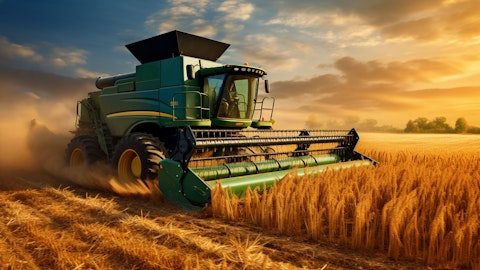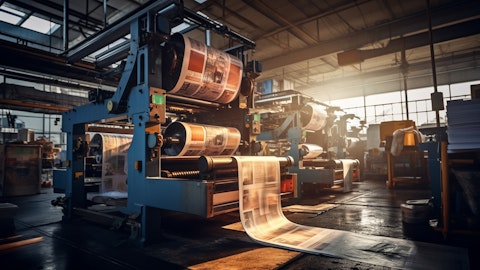Safe Bulkers, Inc. (NYSE:SB) Q3 2025 Earnings Call Transcript November 26, 2025
Operator: Thank you for standing by, ladies and gentlemen. Welcome to Safe Bulkers Conference Call on the Third Quarter 2025 financial results. We have us with us today, Mr. Polys Hajioannou, Chairman and Chief Executive Officer; Dr. Loukas Barmparis, President; and Mr. Konstantinos Adamopoulos, Chief Financial Officer of the company. [Operator Instructions] Following the conference call, if you need any further information on the conference call or the presentation, please contact Capital Link at (212) 661-7566. I must advise you that this conference is being recorded today. The archived webcast of the conference call will soon be available on the Safe Bulkers website, www.safebulkers.com. Many of our remarks today contain forward-looking statements based on current expectations.
Actual results may differ materially from the results projected from those forward-looking statements. Additional information concerning factors that can cause actual results to differ materially from those in the forward-looking statements is contained in the third quarter 2025 earnings release, which is available on the Safe Bulkers website, again, www.safebulkers.com. I would now like to turn the conference over to our speakers today, Chairman and CEO of the company; Mr. Polys Hajioannou. Please go ahead, sir.

Dr. Loukas Barmparis: Good morning to all. I am Loukas Barmparis, President of Safe Bulkers, and I will do today the presentation, and I’m welcoming you at our quarterly results. Key developments of the previous period include the performance of the IMO Net-Zero framework and the expected gradual market fragmentation due to geopolitical reasons for fees and tariffs resulting in increased market volatility. The dry bulk market recovered compared to the previous quarter, and we sold 2 of our oldest vessels as part of the company’s ongoing fleet renewal strategy. Our company maintains a strong capital structure providing flexibility in our capital allocation. Lastly, we have declared a dividend of $0.05 per share of common stock rewarding our shareholders.
Following a comprehensive review of the forward-looking statements language presented in Slide 2, let us proceed to examine the supply side dynamics in Slide 4. The dry bulk fleet is projected to grow by about 3% on average in 2025 and in 2026 due to stable new deliveries. The order book now stands below 11% of the current fleet. Asset prices are projected to pick up in line with the current freight market. Recycling volumes are anticipated to rise through as market conditions prompted that into older vessels, especially in relation to the 25% of dry bulk fleet being older than 15 years and the overall average age of the dry bulk fleet. As a result, the ship recycling would be double over the next 10 years compared to previous decade as per Bimco projections.
Currently, 15% of ship capacity in the dry bulk order book will be ready to use alternative fuels upon delivery. And out of those ships 52%, they may use methanol, 35% LNG and 13% ammonia or hydrogen. However, the dual fuel order book remains small on dry bulk segment. The postponement in adoption of the global fuel standard by IMO, may bring another path on decarbonization towards more pragmatic solutions. We do have 2 dual fuel new builds on order with delivery in first quarter of 2027. Safe Bulkers fleet now counts 12 Phase 2 vessels on the water, all delivered 2022 onwards. On top of that, 24 vessels have been environmentally upgraded and 11 are eco vessels having superior design efficiencies. 80% of our fleet comprises Japanese built vessels, double the global average of 40%, while our average fleet age of 10.1 years being 2.5 years younger compared to the global average of 12.6 years.
Q&A Session
Follow Safe Bulkers Inc (NYSE:SB)
Follow Safe Bulkers Inc (NYSE:SB)
Receive real-time insider trading and news alerts
Our commercial competitiveness will strengthen as we will be taking delivery of our remaining order book of 6 Phase 3 vessels. By first quarter of 2027, Safe Bulkers fleet will be comprised of 35% Phase 3 vessels, 18 out of 51, positioning us favorably to compete based on the fuel efficiency of our vessels, while the shipbuilding capacity will continue to be constrained, leading to longer lead times. Moving on to Slide 5, we present an overview of the demand and basic commodities trade. The combination of trade war as expected through tariffs, high debt, high interest rates, new fiscal demands and persisting geopolitical tensions, elevated policy uncertainty, straining public finances can pose a considerable down risk for global growth and disinflation.
For our segment, we anticipate an improving freight market rate as a result on the trade truce resulted from the agreement between U.S. and China with an increasing focus on the existing fleet decarbonization and energy efficient new builds. The global GDP growth expectations for 2026 and 2027 as reflected in the IMF’s October forecast call for a growth of about 3% in the coming years, accompanied by a gradual control of inflationary pressures. According to Bimco the forecasted global dry bulk demand growth will be 2% in 2026, followed by 1.5% in 2027, with grains and minor bulks being the best performing sectors. China and India are gradually boosting domestic coal production, reducing import demand. China has been rapidly phasing out fossil fuels from electricity generation, boosting renewables, reducing import dependence.
China’s economy is still being affected by property sector crisis and manufacturing overcapacity. Trade tensions between the U.S. and China, although truce has been reached, remain a key source of global economic uncertainty. On the good side, additional Chinese purchase of U.S. soya beans were reported with a total of about 1 million tons sold since the U.S.-China trade war truce while the U.S. has suggested that China could purchase up to 12 million tons of U.S. soybeans. India continues to perform and is projected to experience the fastest growth among emerging economies with a forecasted 6.2% GDP increase in 2026. Its expanding domestic market and manufacturing sectors may continue to contribute positively to the dry bulk demand with infrastructure investments playing a vital role.
The Japanese government approved a $135 billion economic stimulus package, the country’s largest package since the COVID period amidst slowing economic growth with measures also containing dedicated funding for the Japanese shipbuilding industry. Currently, in the spot rate market, multiple miners continue offering cargoes in both basins. Steady gains were made in the Atlantic with sentiment supported by expectation of further U.S. China grain sales and a tight forward tonnage list. Fresh U.S. grain cargoes also boosted the NOPAC rates. Looking forward in 2026 and 2027 an expected decline in coal cargoes and limited iron ore cargo growth will negatively impact demand growth. Instead, growth is expected to come from stronger grain and minor bulk shipments and from longer sailing distances.
Summing up the supply-demand equilibrium on Slide 6. The supply growth is expected to continue to outpace demand. The freight market has rebounded recently during the start of the third quarter. All 8 of our Capes are presently period chartered with an average remaining charter duration of almost 1.7 years at an average daily charter rate of $24,800 providing us visibility of cash flows, topping $124 million in contracted revenue backlog from Capes alone. Moving to Slide 8, we present an overview of our quarterly highlights. We have declared our 16th consecutive quarterly dividend of $0.05, representing 4.1% dividend yield. At the same time, our free cash flows finances our newbuilding program. We maintained ample liquidity, profitability and capital resources of $390 million and a comfortable leverage of about 35%.
We sold 2 of our oldest vessels in our fleet in line with our fleet renewal strategy and achieved 0 vessels in D & E carbon intensity CII rating of IMO for 2024 as described in our 2024 sustainability report. On Slide 9, we present our returns to shareholders of $83.9 million paid in common dividends and $74.9 million paid in the form of shares repurchases since 2022. We have been consistent in generating sustainable returns across market fluctuations because of our track record, hands-on management and our overall business model. Concluding the company update on Slide 10, we present our strong fundamentals. Safe Bulkers is a dry bulk company with $496 million market cap, 45 vessels in the water having $274 million scrap value. We maintain significant firepower with $124 million cash and $267 million in undrawn RCFs, revolving credit facilities and $176 million borrowing capacity against our significant order book of 6 newbuilds, mainly in Japanese shipyards.
We focus on our majority Japanese build-fleet advantage, on fleet energy efficiency and lower CO2 taxation reflected in our CII rating of 0 vessels on the bottom ratings of D & E. We maintain a technologically advanced fleet, strong balance sheet, comfortable leverage and low net debt per vessel of $8.7 million for a 10.1-year old fleet. We have built a resilient business model with cash flow visibility of $164 million in revenue backlog, healthy expansion for a sizable fleet that achieves scale and a meaningful 4.1% annualized dividend yield positioned to leverage on its fuel efficiency. I now pass the floor to our CFO, Konstantinos Adamopoulos, for our quarterly financial review. Konstantinos, the floor is yours.
Konstantinos Adamopoulos: Thank you, Loukas, and good morning to everyone. During the third quarter of 2025, we operated in a weaker charter market environment compared to the same period in 2024 with decreased revenue due to lower charter hires and decreased earnings from scrubber fitted vessels. Moving on to Slide 12 with our quarterly financial highlights for the third quarter of 2025 compared to the same period of 2024. Our adjusted EBITDA for the third quarter of 2025 stood at $36.1 million compared to $41.3 million for the same period in 2024. Our adjusted earnings per share for the third quarter of 2025 was $0.12. This is calculated on a weighted average number of 102.3 million shares compared to $0.16 during the same period last year, calculated on a weighted average number of 106.8 million shares.
In the graph on the top, during the third quarter of 2025, we operated 46.51 vessels on average, earning an average time charter equivalent of $15,507 compared to 45.27 vessels on average, ending TCE of $17,108 during the same period in 2024. Our daily vessel earning expenses decreased by 4% to $5,104 for the third quarter of 2025 compared to $5,311 for the same period in 2024. This daily running expenses, excluding dry docking and predelivery expenses increased by 1% to $5,060 for the third quarter of 2025 compared to $4,999 for the same period last year. In Slide 13, we see a quick overview of our quarterly operational highlights for the third quarter of 2025 in comparison to the same period last year. Let’s continue now to Slide 14, where we present our balance sheet analysis and noting that our assets are presented in the book value.
The company maintains a healthy balance sheet supported by robust equity base at the concerned levels. Strong liquidity and ample cash reserves provide significant financial flexibility to navigate market volatility and take advantage of market opportunities. Our capital structure positions the company for sustainable long-term growth and resilience. Concluding our presentation in the last slide, #15, we present our daily free cash flow for the 9 months of 2025, illustrating the company’s ability to generate free cash flows highlighting disciplined cost control and efficient vessel operations. I would like to highlight that based on our financial performance, the company’s Board of Directors has declared $0.05 dividend per common share. The company has maintained a healthy cash flow position of $187 million as of November 21, 2025 and another $210 million in available undrawn revolving credit facilities, so a combined liquidity and capital resources just shy of $400 million plus a contracted revenue of $164 million.
This underscores our capacity to support debt service, the investment and shareholder returns at the same time which enable us to expand the fleet, build a resilient company and create long-term prosperity for our shareholders. Thank you, and we are now ready for the Q&A session.
Operator: [Operator Instructions] We reached end of our question-and-answer session. I’d like to turn the floor back over for any further or closing comments. With no more questions, I’ll turn it back over to management.
Dr. Loukas Barmparis: Okay. So thank you very much for attending this conference call, and we’ll be in touch next quarter. Thank you very much.
Operator: Thank you. That does conclude today’s teleconference and webcast. You may disconnect your line at this time, and have a wonderful day. We thank you for your participation today.
Follow Safe Bulkers Inc (NYSE:SB)
Follow Safe Bulkers Inc (NYSE:SB)
Receive real-time insider trading and news alerts





